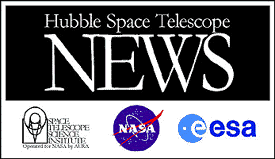 PRESS RELEASE NO.: STScI-PR99-19
PRESS RELEASE NO.: STScI-PR99-19
 PRESS RELEASE NO.: STScI-PR99-19
PRESS RELEASE NO.: STScI-PR99-19
CONTACT:
|
Don Savage NASA Headquarters, Washington, DC (Phone: 202-358-1547)
Nancy Neal |
Ray Villard Space Telescope Science Institute, Baltimore, MD (Phone: 410-338-4514) |
The Hubble Space Telescope Key Project team
today announced that it has completed efforts to measure precise distances to far-flung galaxies,
an essential ingredient needed to determine the age, size and fate of the universe.
"Before Hubble [Telescope], astronomers could not decide if the universe was 10,000 million or 20,000 million years old. The size scale of the universe had a range so vast that it didn't allow astronomers to confront with any certainty many of the most basic questions about the origin and eventual fate of the cosmos", said team leader Wendy Freedman, of the Observatories of the Carnegie Institution of Washington. "After all these years, we are finally entering an era of precision cosmology. Now we can more reliably address the broader picture of the universe's origin, evolution and destiny."
The team's precise measurements are the key to learning about the expansion rate of the universe, called the Hubble Constant. Measuring the Hubble Constant was one of the three major goals for NASA's Hubble Space Telescope before it was launched in 1990.
For the past 70 years astronomers have sought a precise measurement of the Hubble Constant, ever since astronomer Edwin Hubble realized that galaxies were rushing away from each other at a rate proportional to their distance, i.e. the farther away, the faster the recession. For many years, right up until the launch of the Hubble telescope - the range of measured values for the expansion rate was from 50 to 100 kilometers per second per megaparsec (a megaparsec, or mpc, is 3.26 million light-years).
The team measured the Hubble Constant at 70 km/sec/mpc, with an uncertainty of 10 percent. This means that a galaxy appears to be moving 160 thousand miles per hour faster for every 3.3 million light-years away from Earth.
"The truth is out there, and we will find it", said Dr. Robert Kirshner, of Harvard University. "We used to disagree by a factor of 2; now we are just as passionate about 10 percent. A factor of two is like being unsure if you have one foot or two. Ten percent is like arguing about one toe. It's a big step forward."
Adds Dr. Robert Kennicutt of the University of Arizona, a co-leader of the team: "Things are beginning to add up. The factor of two controversy is over."
The team used the Hubble telescope to observe 18 galaxies out to 65 million light-years. They discovered almost 800 Cepheid variable stars, a special class of pulsating star used for accurate distance measurement. Although Cepheids are rare, they provide a very reliable "standard candle" for estimating intergalactic distances. The team used the stars to calibrate many different methods for measuring distances.
"Our results are a legacy from Hubble Telescope that will be used in a variety of future research", said Dr. Jeremy Mould, of the Australian National University, also a co-leader of the team. "It's exciting to see the different methods of measuring galaxy distances converge, calibrated by the Hubble Space Telescope."
Combining the Hubble Constant measurement with estimates for the density of the universe, the team determined that the universe is approximately 12 billion years old - similar to the oldest stars. This discovery clears up a nagging paradox that arose from previous age estimates. The researchers emphasize that the age estimate holds true if the universe is below the so-called "Critical Density" where it is delicately balanced between expanding forever or collapsing [in some future]. Or, if the universe is pervaded by a mysterious force pushing the galaxies farther apart, in which case the Hubble measurements point to an even older universe.
The universe's age is calculated using the expansion rate from precise distance measurements, and the calculated age is refined based on whether the universe [expansion] appears to be accelerating or decelerating, given the amount of matter observed in space. A rapid expansion rate indicates the universe did not require as much time to reach its present size, and so it is younger than if it were expanding more slowly.
[notes] by ARVAL
For more information and pictures relative to this release,
link to
Hubble Completes Eight-Year Effort to Measure Expanding Universe
(HubbleSite - NewsCenter. May 25, 1999).
For more information, link to
HST findings shed new light on the fate of the Cosmos
(in the Web site of Science@NASA).
![]() The Space Telescope Science Institute is operated by the
Association of Universities for Research in Astronomy, Inc. (AURA),
The Space Telescope Science Institute is operated by the
Association of Universities for Research in Astronomy, Inc. (AURA),
for NASA, under contract with the
Goddard Space Flight Center, Greenbelt, MD.
The Hubble Space Telescope is a project of international cooperation between NASA and the
European Space Agency (ESA).
Recent investigations have found that the expansion rate of the cosmos
began speeding up about five to six billion years ago.
See ARVAL - Hubble Finds Evidence for Dark Energy in the Young Universe.
![]() Updated: November 19 '06
Updated: November 19 '06
Best seen with MS Internet Explorer.
Back: STScI - Background Information
Messages: